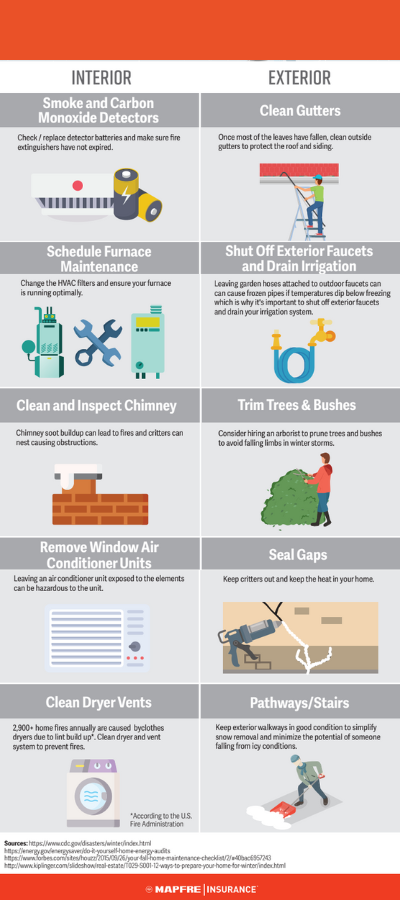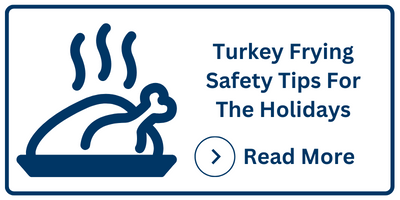
As winter approaches, we’re dedicated to helping you stay safe and save money. We’ve compiled a set of invaluable insurance tips to make this season worry-free. Discover how to cut down on heating costs, safely fry your holiday turkey, winterize your home, and navigate the roads during darker days. Your safety and comfort are our top priorities, and we’re here to support you every step of the way. Click below to get started.

10 Ways To Save On Your Heating Bill This Winter
Content provided by AAA’s Insurance Partner: MAPFRE Insurance
Everyone is looking for ways to save money these days as prices rise on just about everything. If you live in a state prone to cold weather and use gas, oil, electricity, or a wood stove, there are numerous ways you can save on heating costs for your home this winter.
One sure fire way to keep those costs down is to simply dress warmer. While you might want to throw on an old T-shirt and shorts, it’s better to wear an old sweatshirt and sweatpants and cover up in a warm blanket or comforter. There are many other ways to save on heating costs:
1. Turn Down Thermostat
Setting your thermostat between 68 and 72 degrees when there are people inside the home and 58 and 62 degrees when the house is empty or you are asleep can help you minimize your energy usage and costs. While you want to set the temperature lower at some points of the day, you don’t want your pipes to freeze and burst, leading to pricey repairs.
2. Use Smart or Digital Thermostat
Installing a smart or digital thermostat, which can be controlled with your smartphone or tablet, is another way to save on your heating bill. These types of thermostats not only allow you to control the temperature when you’re not home, but they can notify you of maintenance needs and energy usage. Some energy companies even offer rebates or discounts for switching from a traditional thermostat.
3. Remove AC Units
Hopefully you already removed your window air conditioner units as leaving them exposed to the elements can be hazardous to the unit. But leaving them in also lets cold air inside your home.
4. Check or Add Insulation
The insulation in your home provides resistance to heat flow, according to the U.S. Department of Energy (DOE). You should check to make sure you have enough insulation by putting down an extra layer in your attic and/or adding blown-in insulation to existing walls or adding proper insulation during any renovations to your home when the walls are open.
5. Seal Doors and Windows
In addition to checking insulation, sealing windows and doors with new weatherstripping will help to keep cold air out and warm air inside.
6. Check Ducts
Ducts are one way cold air will seep into your home, causing your home heating costs to soar. While you can hire a professional to repair the duct leaks, you can probably seal them yourself with metal tape or mastic sealant.
7. Reverse Ceiling Fans
If your ceiling fan has a reverse switch, you can run the fan in a clockwise direction after heat is turned on for a good way to circulate all that heat that is rising and to save on energy costs.
8. Let Sunlight In
Simply opening your blinds and curtains during the day will allow sunlight in to warm up your home.
9. Close Fireplace Damper
Fireplaces are a great way to keep warm! But when you’re not using it, make sure your damper is closed so no cold air is leaking into the house.
10. Have Furnace Serviced
Your furnace should be inspected by a licensed contractor annually and replaced when recommended. Having the furnace cleaned and inspected will not only help to avoid a fire or interruption in service, but having a dirty filter makes your furnace work harder and leads to an increase on your heating bill.
There still other ways you can keep your heating costs down during the winter (and frankly year-round). One suggestion by the Department of Energy (DOE) is to do a home energy audit or energy assessment to see how efficient your heating and cooling systems are and where your home is wasting energy. Your utility company may be able to provide this service or refer you to someone who does.
The DOE also suggests to make sure your appliances, heating, ventilation, and air conditioning equipment all have the ENERGY STAR logo and EnergyGuide label.
The ENERGY STAR logo is on all qualified products that meet specific standards for energy efficiency, according to the DOE. These types of products exceed the federal minimum standards for efficiency and quality. The EnergyGuide label, which is bright yellow and black, helps consumers figure out how much energy an appliance uses compared to the energy use of similar appliances. The labels, however, do not show you which appliance is the most efficient – only the annual energy consumption and operating cost.
Hopefully these tips were helpful in preparing your home for colder days ahead and while also saving you money! Just as important as winterizing your home, make sure you also have the right coverage for your home and auto insurance with AAA.

Turkey Frying Safety Tips For The Holidays
Content provided by AAA’s Insurance Partner: MAPFRE Insurance
An average of 170,000 residential building fires were reportedly caused by cooking in 2021, according to the U.S. Fire Administration (USFA). Of those fires, there were an average of 135 civilian deaths and 3,000 civilian injuries. The fires resulted in a total property loss of $494,200,000.
The biggest day for home cooking fires is Thanksgiving with an average 1,600 fires reported every year.
If your tradition is to roast your turkey in the oven, there are several kitchen safety precautions you should take. But what if you decide to try your hand at deep frying the turkey?
First, fire officials highly recommend not using a turkey fryer. But IF you are going to, head outside and follow these safety precautions from the USFA:
Use fryer outside
Turkey fryers should always be used outside and not in inclement weather like wind, rain or snow, as precipitation can make the oil spatter and the mixture of oil and water can cause a fire.
Make sure fryer is in correct place
A fryer should be at least 10 feet from your home and not under roof eaves, awnings, a porch, or trees. When using a fryer, ensure it is on a flat, even surface to avoid tipping and spilling hot cooking oil.
Check the fryer
Before using the fryer, check the propane tank for leaks.
Start with a thawed turkey
You can safely fry your turkey by starting with a fully thawed bird. A frozen turkey will cause hot cooking oil to splatter when the bird enters the fryer, which can cause a fire.
Don’t overfill the pot
Don’t overfill the fryer with oil; an overfilled pot will spill over when the turkey is put in. You can first test the amount you need by filling the pot with water.
Pay attention and protect yourself
Once you start cooking, do not leave the turkey unattended and pay attention to the temperature of the oil. You can monitor the temperature by using a kitchen thermometer attached to the side of the fryer. While cooking, make sure you use oven mitts, as the lid and pot handles can get extremely hot.
Keep kids and pets away
While the turkey is in the fryer, you should also ensure children and pets are kept at least 3 feet away.
Keep combustibles away
In addition, keep anything flammable away from the fryer and things like towels and aprons. In the event of a fire, have a fire extinguisher close by.
Avoid drinking alcohol while cooking
Alcohol is not only flammable, but it can impair judgement if too much is consumed. Save the alcohol for AFTER your meal is cooked or at least do not keep it near an open flame.
What insurance covers in the event of a fire
Your standard homeowner’s policy with MAPFRE will usually cover your losses should certain events like a major fire, heavy rain, or heavy snow damage your home’s interior or exterior.
We hope it would never happen, but in the event you accidentally have a fire due to frying your turkey and your home or other structures are ignited, you would probably be covered under the following:
- Other Structures
- Personal Property
- Dwelling Liability Coverage
If someone visiting your property were injured by a fire, Liability Coverage would take effect. However, if a household member were injured, they would not be covered by your Homeowners Liability Coverage. Still, hopefully, you have the proper health insurance coverage to get the care they need.
Make sure your homeowner’s insurance policy is up-to-date by contacting AAA!

Winterizing Your Home – Inside and Out!
Content provided by AAA’s Insurance Partner: MAPFRE Insurance
With temperatures falling across many parts of the country, it’s a good time to start thinking of preparing your home for harsh winter conditions like snow and ice.
This process, called winterization, is usually performed in the fall before excessive cold arrives. Maintenance on both the exterior and interior of your home during this time can not only protect the structure from weather-related catastrophes, but it can also save you money by way of lower utility bills.
To winterize the inside of your home, follow this maintenance checklist:
- Test smoke and carbon monoxide detectors at least once a month to make sure they are working and make sure fire extinguishers have not expired
- Locate and seal air leaks, check insulation and evaluate appliances (you could also work with a professional home energy auditor if you prefer)
- Vent the space between the insulation and roof sheathing so that any heat that does leak is carried away
- Schedule furnace maintenance to make sure it is running properly and that HVAC filters are changed
- Get chimney cleaned and inspected as blockages and soot buildup can lead to fires
- Remove window air conditioner units (leaving an AC exposed to the elements can be hazardous to the unit)
- Reverse ceiling fans (for greater energy savings, if the ceiling fan has a reverse switch run the fan in a clockwise direction after heat is turned on)
- Remove lint and debris from clothes dryer vents to prevent fires
Winterizing the outside of your home is just as important. Here is a separate maintenance checklist you can follow:
- Remove leaves, sticks and other debris from gutters so that melting snow and ice can flow freely
- Make sure drains slope away from the home (on a slope that is at least 6 vertical inches over 10 feet). This will keep water away from the foundation which can lead to cracks and leaks
- Shut off exterior faucets, remove and drain garden hoses and drain irrigation system. Leaving hoses attached to outdoor faucets can cause water to back up in faucets and pipes inside interior walls, which can cause frozen pipes
- Trim trees and brushes to avoid falling limbs in winter storms
- Make exterior repairs to damaged areas, like the roof, siding and foundation, ahead of storms
- Seal any gaps to not only keep animals out of your home but to keep the heat inside
- Repair outdoor steps and handrails to ensure proper footing and safe winter walking when it is slippery
- Wear proper footwear with visible treads when walking on slippery outdoor surfaces
- When treating your snow or ice-covered driveway or sidewalk, be sure to use a rock salt or ice melt that won’t do surface damage or harm pets

We hope these tips were helpful in preparing your home for colder, snowy days ahead. Winterizing your home both inside and out is critically important, just like making sure you have the right coverage for your home and auto insurance with AAA.

Driving Safely After The Clocks Fall Back
Content provided by AAA’s Insurance Partner: MAPFRE Insurance
We’ve officially turned the clocks backward an hour, which means it now gets darker outside sooner. According to the NHTSA, fatal accidents are three times more likely to happen at night than during the daytime. So we’ve pulled together a few tips to help you drive safer during nighttime hours.
Use Your Lights
This is a no brainer, but make sure to use your headlights to stay visible not only in the dark, but in bad weather conditions such as rain, snow or hail as well. While you’re at it, test all your lights including low beams, high beams, daytime running lights, turn signals and brake lights. Don’t forget to check the angle of your headlights too – too much of an angle can be blinding to other drivers or not illuminating enough for you.
Be A Defensive Driver
Night time driving poses many risks, some of which include not so stellar drivers, nocturnal animals and unseen road hazards. So prepare for the worst and drive defensively.
Take Care of Yourself
Making sure you’re comfortable and alert can help make nighttime driving easier. This means adjusting your dashboard lights to a less distracting brightness, getting your eyes checked to make sure you don’t need a nighttime driving prescription, and not driving while drowsy.
Plan Your Route
We’re all busy and we’ve all got places to be, but planning your route and slowing down may decrease the likelihood of being involved in a crash at night. So while figuring out which road you’d like to travel, try to pick the route that is well lit and has more than one lane. Don’t forget to slow down too, as according to the NHTSA speeding-related crashes are responsible for 37% of nighttime-driving fatalities.





